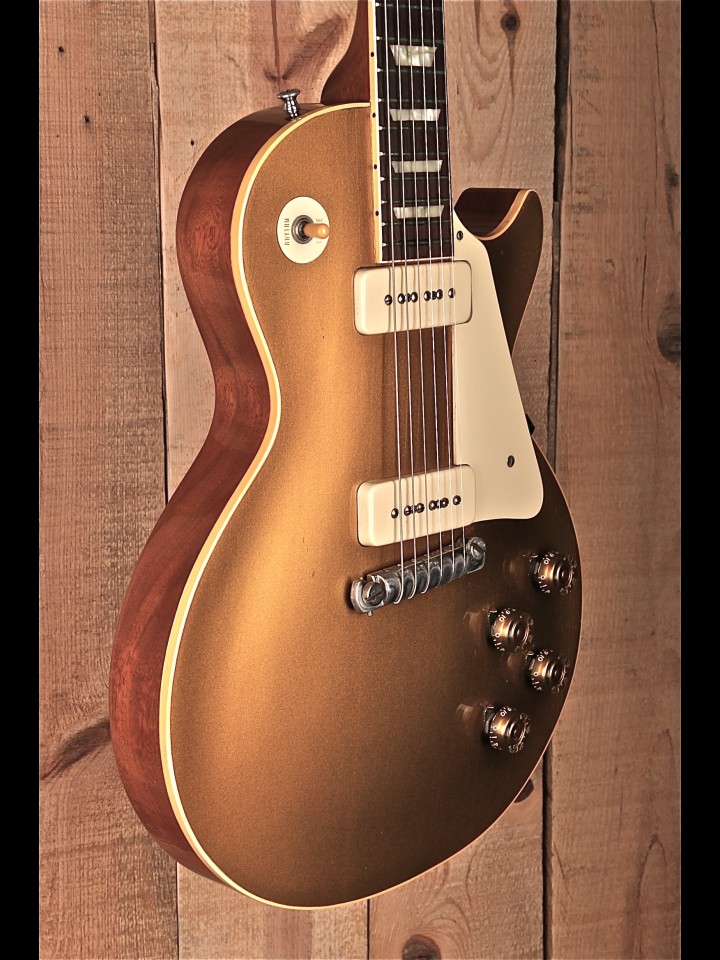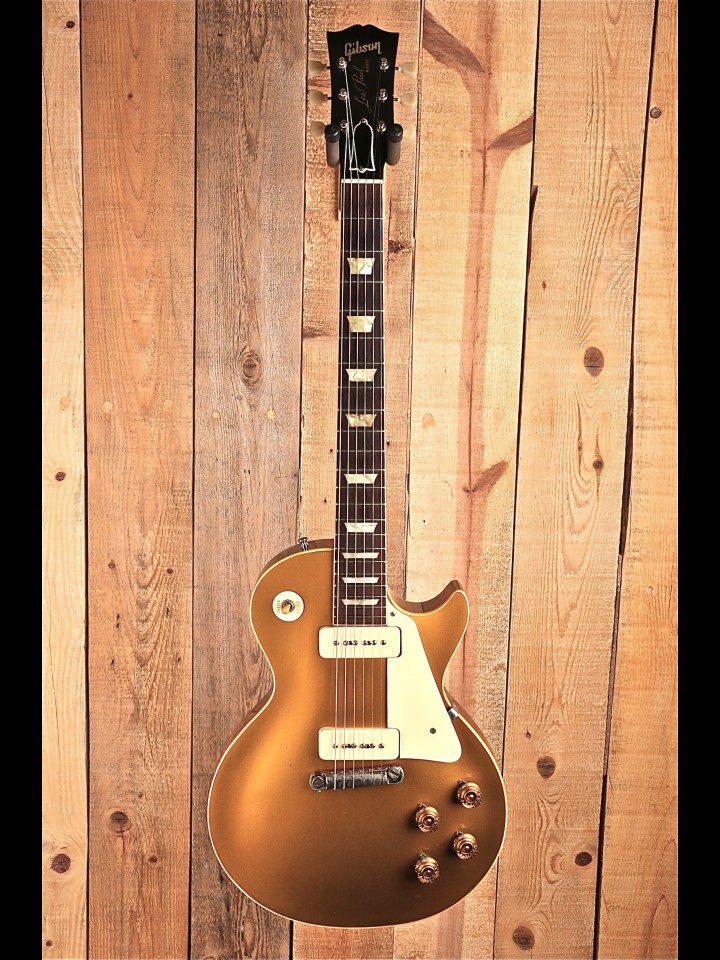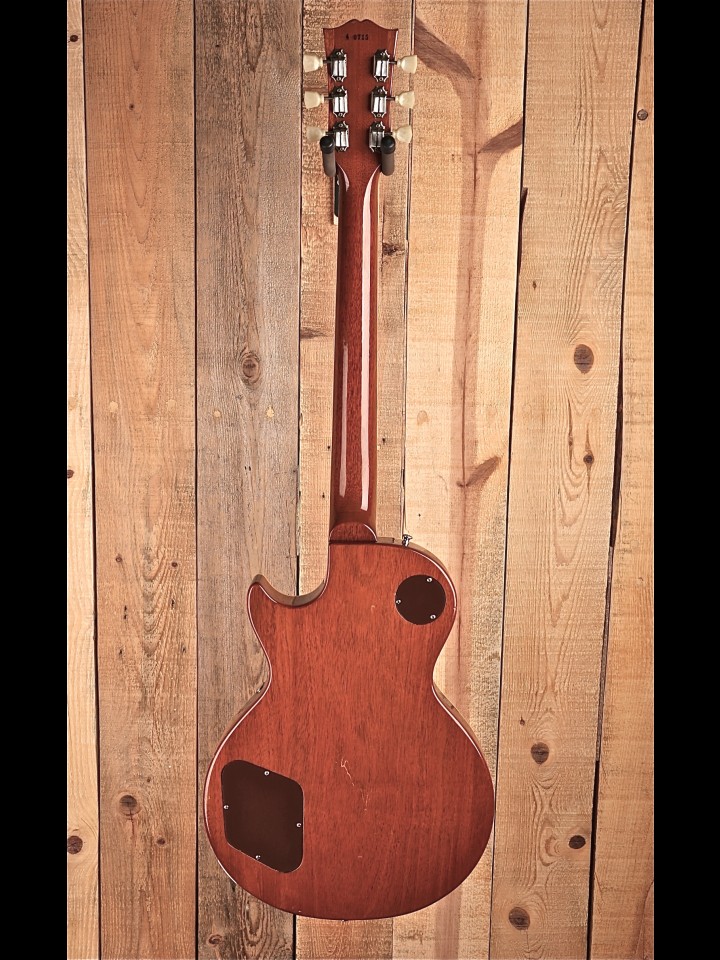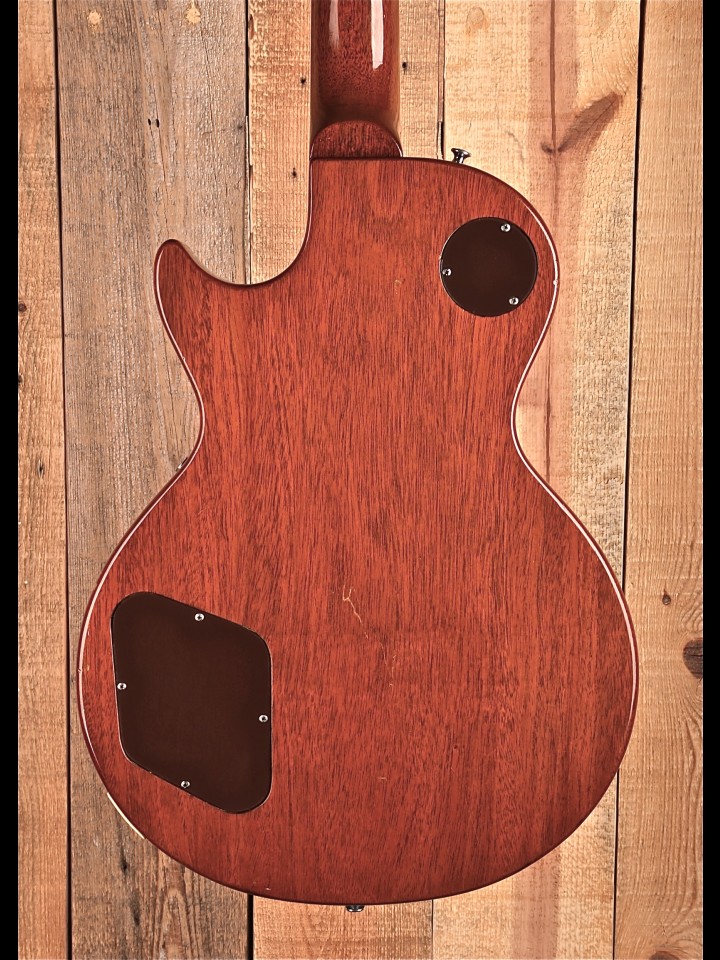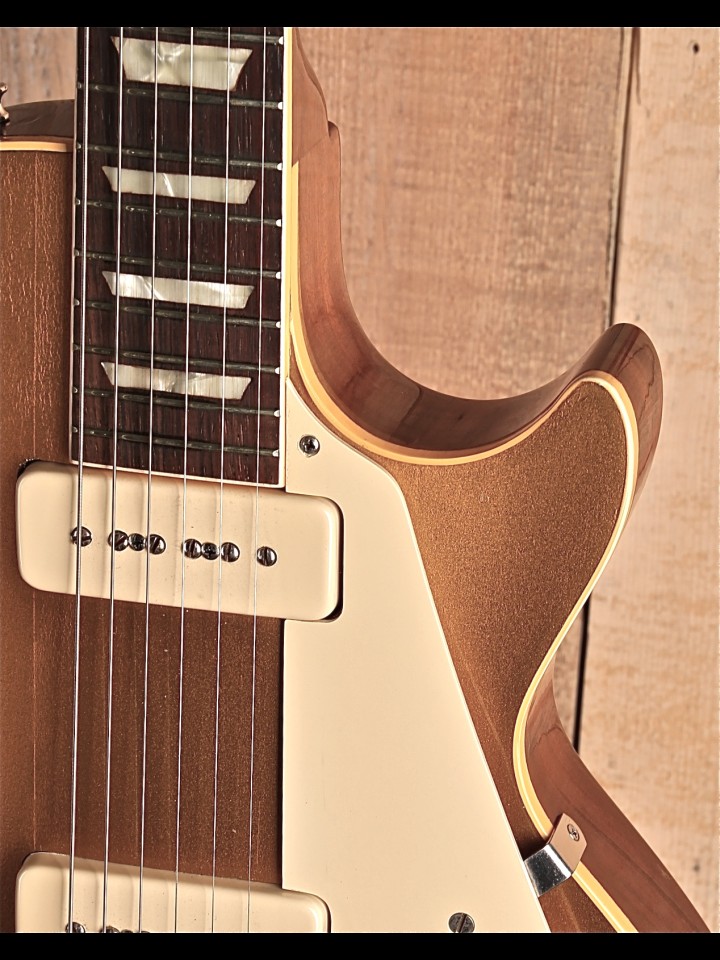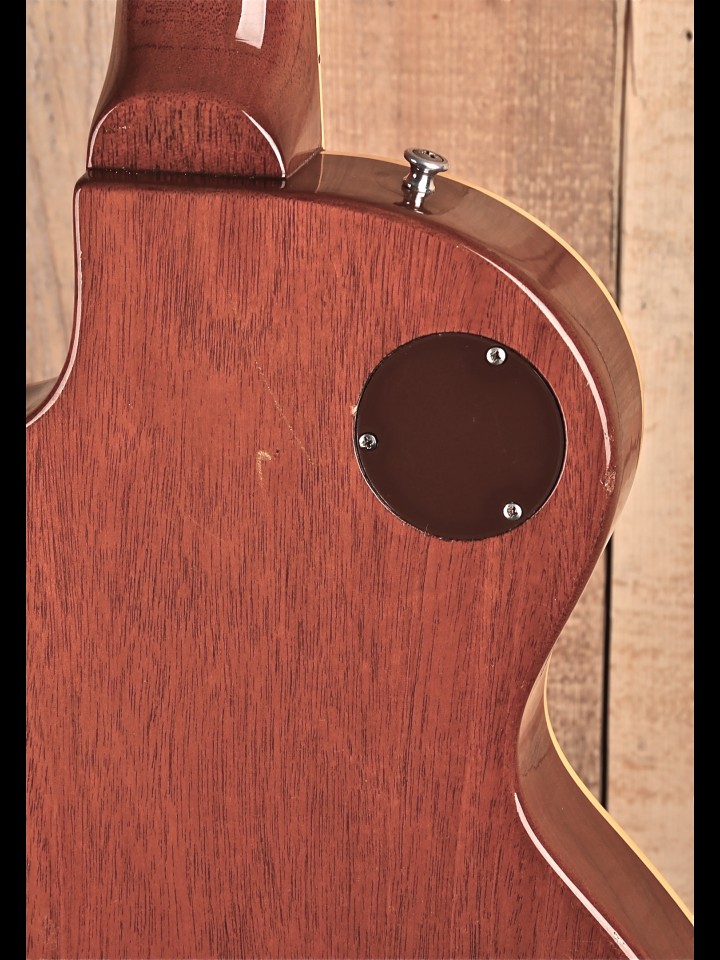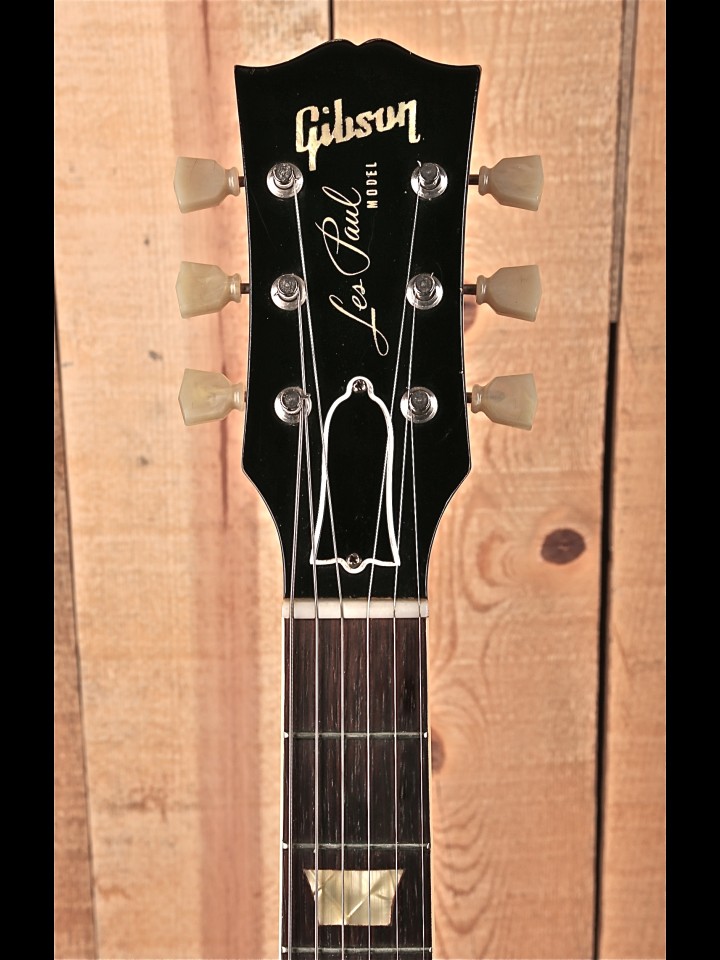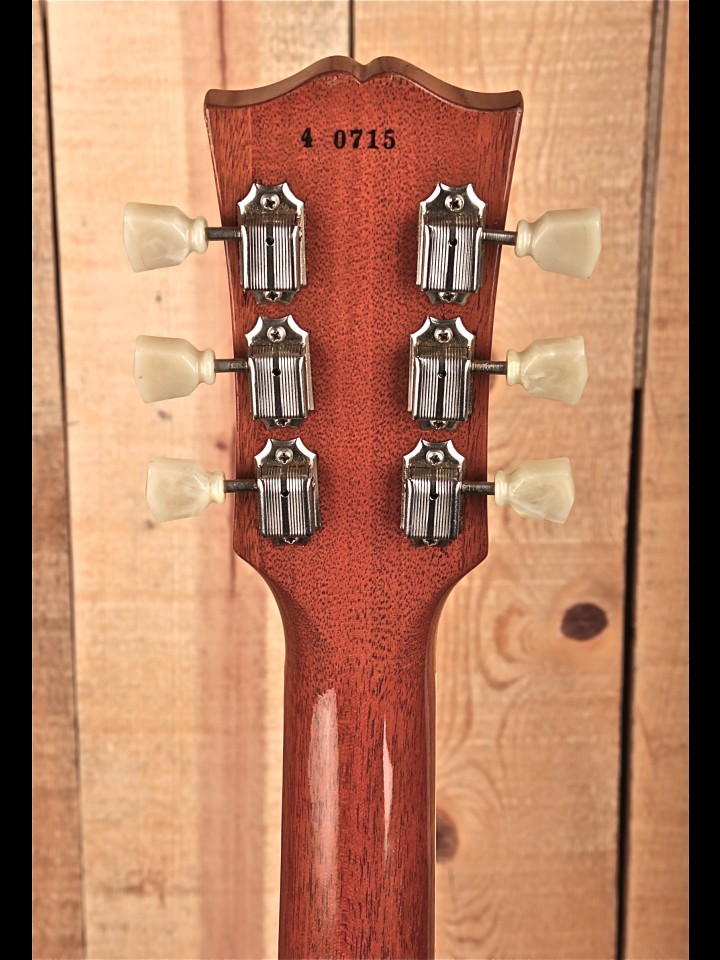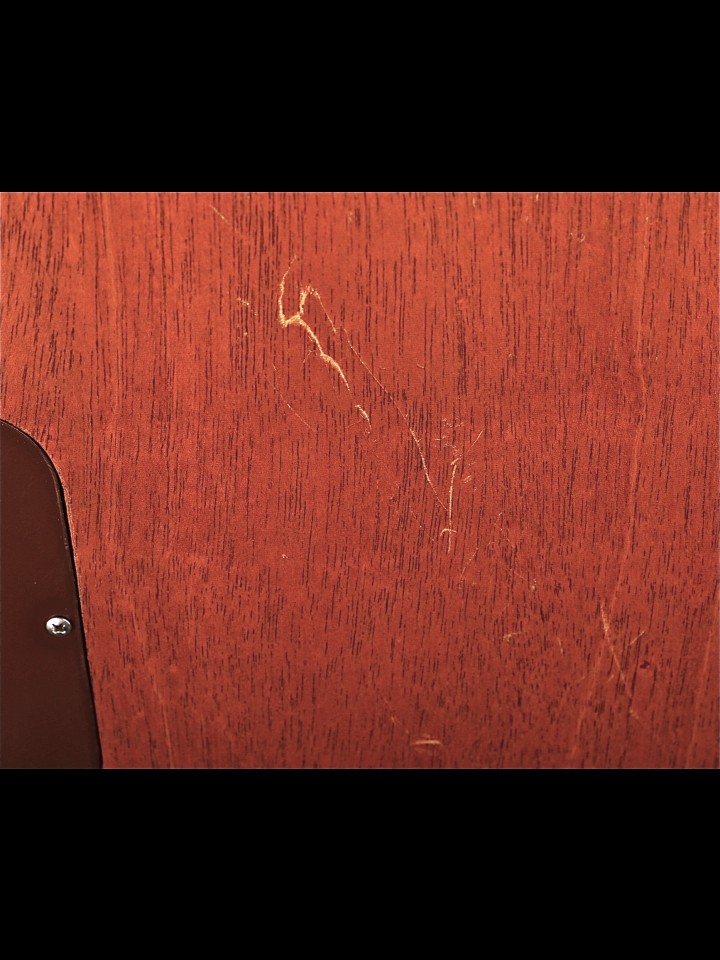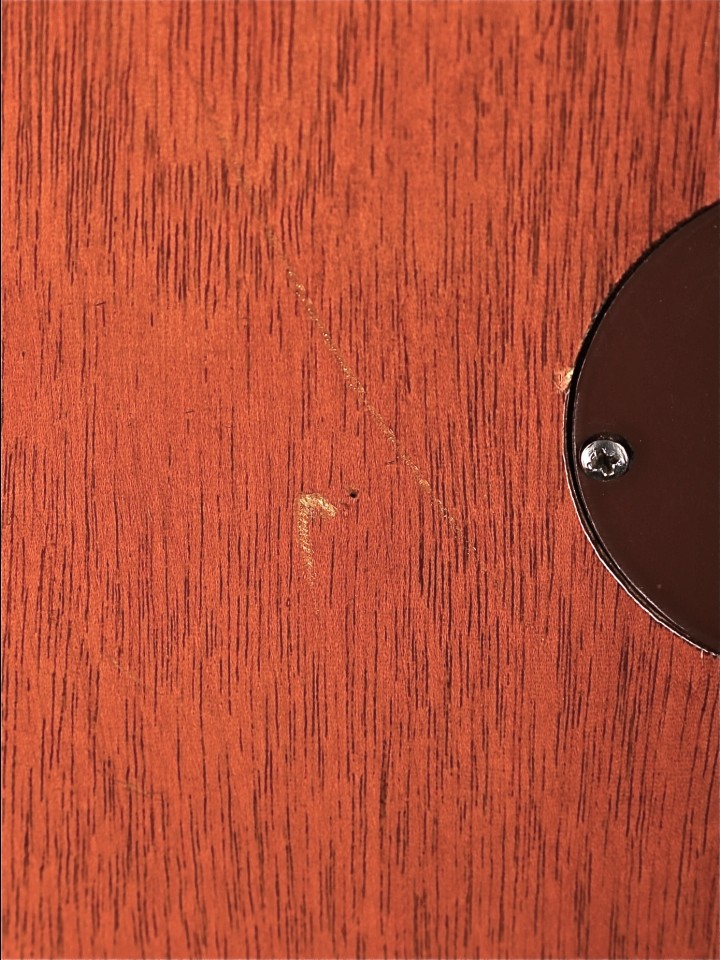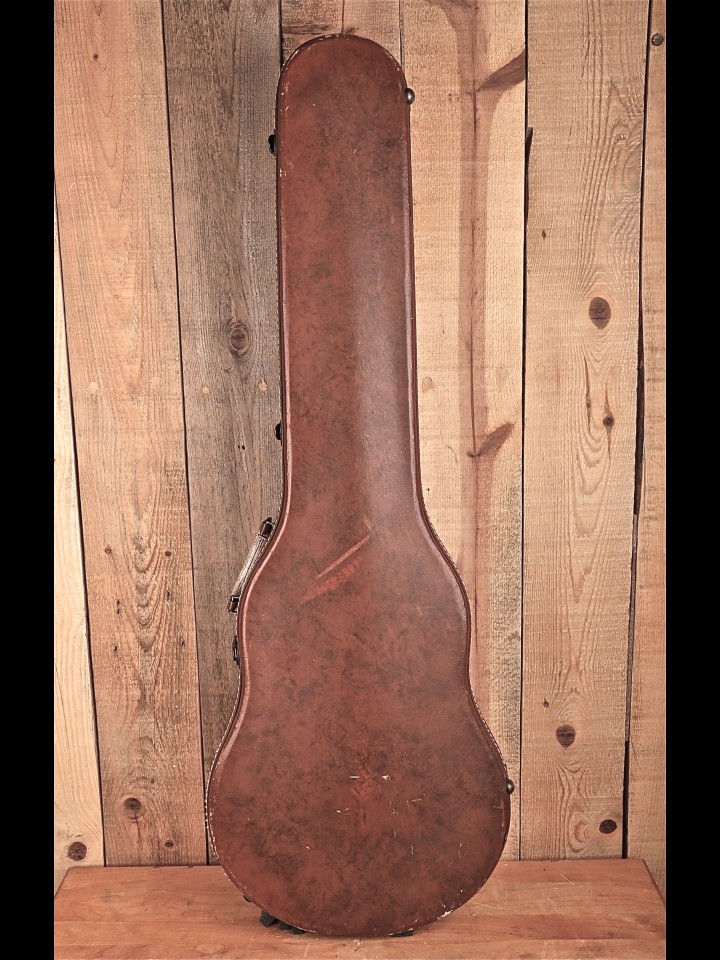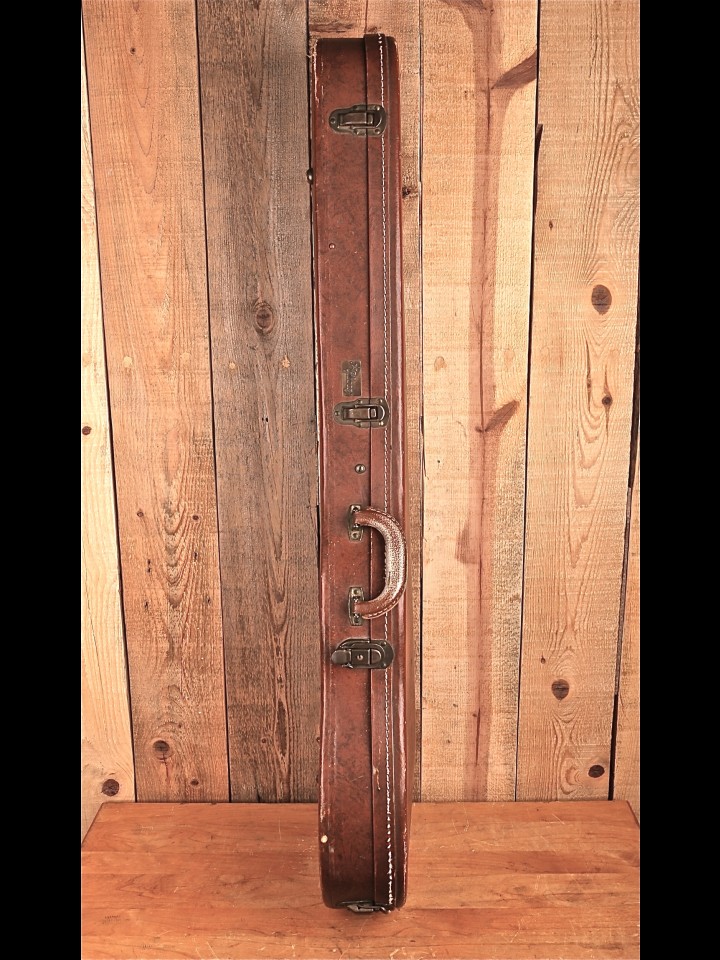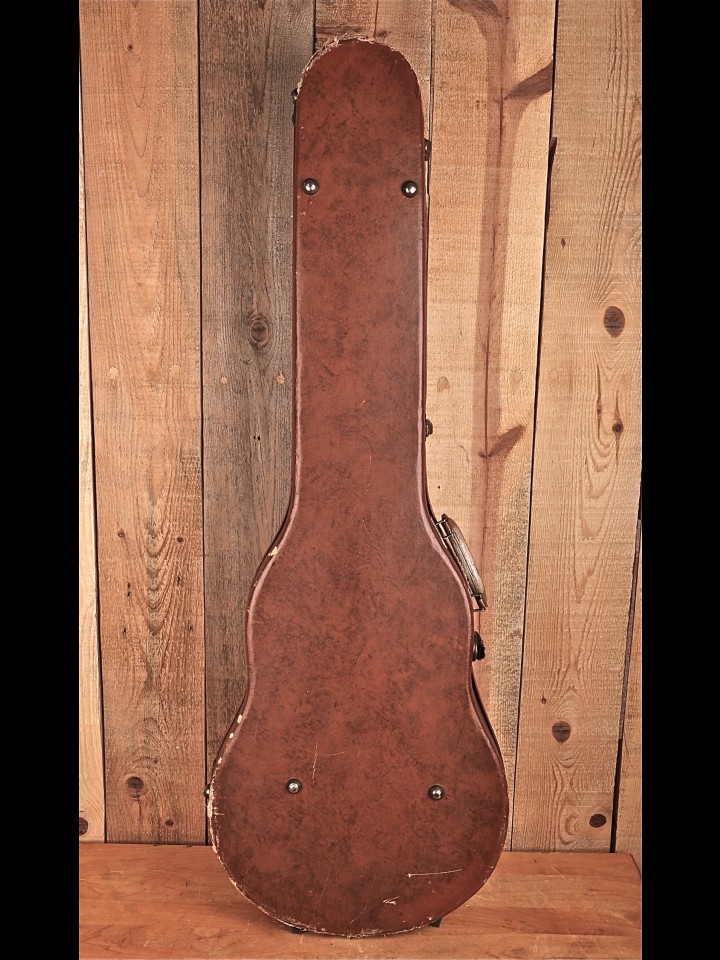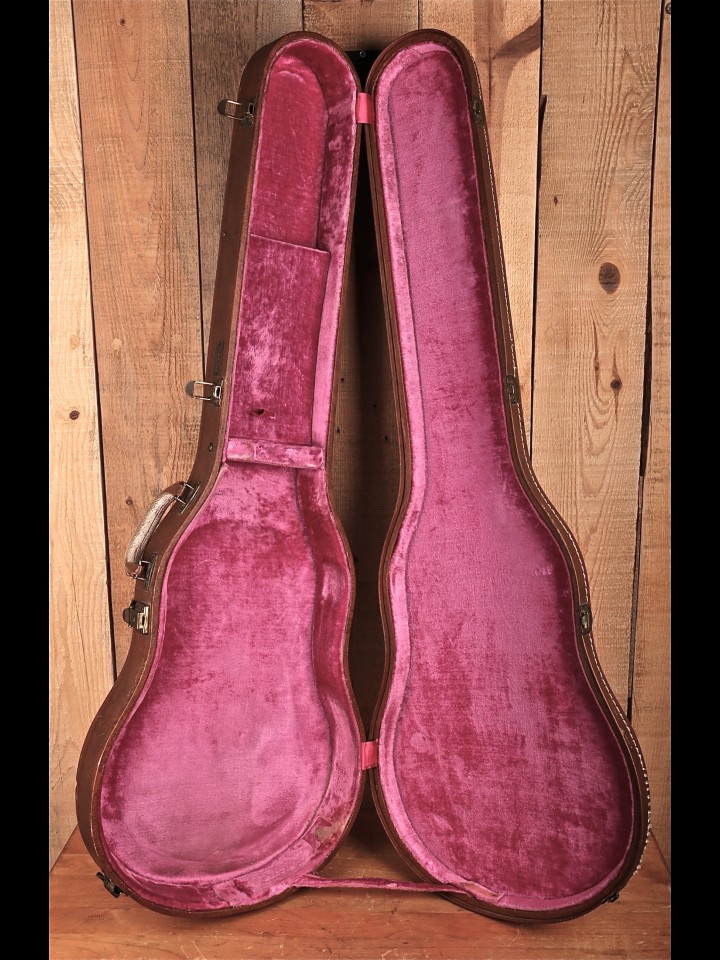1954 Les Paul Goldtop
When it comes to vintage guitars, there are indeed very few instruments that compete with a Gibson Les Paul made between the mid-1950s and 1960 in terms of price and desirability. So, when this 1954 Les Paul Standard “Goldtop” number 4 0715 darkened our door, the world practically stood still! Being dyed-in-the-wool guitar nerds, we are always excited to encounter an interesting guitar, especially a vintage instrument that has survived the passage of so many years. However, to have the experience of lifting a tantalizingly clean old case up onto the counter, opening it to receive a healthy waft of that distinctive old guitar musk, and then reveal an all-original true collector grade instrument?! Well, that’s some powerful catnip to us guitar addicts, and a exceedingly rare privilege—in fact, it’s possible that at least one employee fainted that day, following an intense episode of “the vapors.” Needless to say, we are honored to have such a historically significant and beautiful rarity in our midst; and, accordingly, such a guitar deserves a healthy degree of exposition, beginning with a little historical context.
Prior to introducing the Les Paul model in 1952, Gibson’s focus was very much on carved arched top guitars and flattop acoustic guitars. Of course, Gibson had been early to embrace the notion of amplifying a guitar with the introduction of the ES-150 (a.k.a. the Charlie Christian model) and the E-150 lap steel with its accompanying amplifier, the EH-150, in 1936. Yet, Gibson was evidently a bit skeptical of the notion of a solid body electric guitar, which first began to appear in a viable form in the late 1940s thanks to the likes of Paul Bigsby and Leo Fender—although, Rickenbacker and Doc Kauffman are, in fact, credited with the first “Spanish” style (i.e., not lap steel) electric solid body guitar, the Vibrola Spanish guitar, almost a decade prior. Gibson’s hesitation in this regard was made abundantly clear to a young Lester William Polsfuss when he approached the company in 1939 with his ad hoc solidbody guitar (famously known today as “the Log”), as he was effectively laughed out of the building. However, roughly ten years later, Gibson found itself eating some crow and singing a different tune!
Confronted with the evident success of the plucky West Coast upstart Leo Fender, Gibson was forced to acknowledge the change in the wind and the legitimate demand for a compact, feedback-friendly, solidbody guitar. Thankfully, Gibson’s freshly-minted president, the legendary Ted McCarty (who had only joined the company in 1948 before being promoted to president in 1950), was eager to develop a competitive guitar. Suddenly, that kid with the cobbled-together log thing didn’t seem so crazy! And to rub salt in the wound, that kid had since become a national success under the name Les Paul with companies clamoring for his endorsement. Thus, work on the first Les Paul prototype began in late 1950.
A savvy business man with a keen eye for design, McCarty recognized that Gibson had the manufacturing facility to produce a guitar with a carved top that his competitors could not easily replicate. Yet, early efforts to build a solid maple guitar with a wider body template quickly revealed problems with weight. Ultimately, Gibson would settle on what would become a classic compromise: a mahogany body to reduce weight, and a carved maple top to improve sustain. As these elements of the prototype coalesced, Les Paul was satisfied enough with the design to give the guitar his endorsement (purportedly for $1 per unit sold); and, following a final bout of cold feet, where they briefly entertained releasing the model as a Les Paul Model without the Gibson brand, Gibson put their name on the headstock and history was made!
Of course, some revision and tweaking is to be expected with of any new product. Along that line, it was immediately evident that the earliest Les Paul models had some issues, particularly with respect to the neck angle and the trapeze tailpiece. On its own, the inherent lateral play/wiggle room of the trapeze tailpiece created unsatisfactory tuning issues when strings were bent. Les Paul was also displeased with the necessity of wrapping the strings under the tailpiece for proper action, as this precluded him from muting strings with his palm. Ted McCarty responded by creating the wraparound tailpiece, which was introduced in 1953. Yet, Gibson did not hit their stride with the proper neck angle until 1954, when number 4 0715 here rolled off the line. Now, with a proper neck angle and a suitable bridge design, the Les Paul model had finally come into its own. Incidentally, 1954 is also a significant year in the history of the Les Paul model as the Custom (a.k.a. ”Black Beauty” or ”Fretless Wonder”) was introduced the same year with a mahogany top (for a darker tone), low fret height (for smooth play), and a “staple” P-90 pickup (with AlNiCo V magnets) in the rhythm position for a more tonal variety.
The advent of the humbucking pickup (developed by Seth Lover) in 1957 and the introduction of the Cherry Sunburst finish in 1958 we the last major developments in the evolution of the pre-SG body Les Paul. Of these two, the transition to dual-coil humbucking pickups from the single-coil P-90 was by far the most significant, as it represented a fundamental shift in tone. The impetus for the development of the fabled P.A.F. humbucker was, in fact, a pragmatic response to noise issues associated with the 60-cycle hum of a single coil pickup, rather than a desire to simply generate a cleaner and thicker tone. Regardless, this feature clearly separates all of the early Les Pauls from those of the late 50’s and 1960, as well as all of those that eventually followed. And, understandably, once the Les Paul became firmly established as a guitar icon decades later (after years of ebb and flow in popularity), much attention (and money) has been focused on humbucker tone and the early humbucker-equipped Les Pauls.
As a result of this humbucker mania, the extremely attractive qualities of the P-90s found in earlier Les Paul Standards (as well as Les Paul Juniors and Specials of the era) have often been overlooked and underappreciated by the general guitar community. Yet, in recent years, many players have come to prize and even prefer the P-90 pickup for its overall versatility and expressiveness. Unlike a brilliant airy chime of a Fender style single coil of the era, the ‘50s Gibson P-90 has a palpable heft and girth behind the note which generates a unique blend of tonal warmth and clarity with a distinctive bite. These qualities enable a P-90 to generate highly textured clean tones or venture into areas of gritty, less-refined aggressiveness when compared to a humbucker. Having higher output than most any other single coil pickup, P-90s will also push an amplifier into an overdriven state much more readily. This degree of responsiveness, along with the broad middle-of-the-road tonal palette, is indeed inspirational as it translates to an experience where one feels very connected to the guitar. In turn, this connection encourages a player to plumb emotional depths.
Thus, in addition to being a bona fide drool-worthy collector’s piece, this Les Paul Goldtop (one of approximately 1504 produced in ’54) is an absolutely killer instrument with vintage mojo for miles! Whether it be jazz, rock, country, rockabilly, blues or something in between, this incredible 70-year-old guitar still stands ready to meet the challenge. And, no doubt, somewhere on some celestial plane, the young man from Waukesha, Wisconsin with “the Log” is flashing a proud (and perhaps slightly mischievous) smile for all the fuss that has been created in his name.
Condition:
For its age, this 1954 Les Paul Standard is in simply remarkable condition! Apart from a replaced Switchcraft pickup selector switch (the original is present), the guitar is, by all indications, completely original. While the guitar is about as cosmetically clean as one could hope for, it has clearly seen at least some use since it rolled off the line. In the grand scheme of things, any and all wear on this guitar could be described as very minor, even by well-maintained-honest-wear standards; but, in light of this guitar’s pedigree, we’ve detailed this wear as best as possibly below:
- Some lacquer sink is apparent along the top seams—this is most evident on the bass side, running from the shoulder to the bridge anchor.
- There are a couple very minor top dings: one measuring approximately 3 x 1 mm, situated roughly one inch to the left of the bass side bridge anchor; another is a circular impression measuring approximately 2 ½ millimeters in diameter, situated to the right of the pickguard at the cutaway horn.
- We note some very slight finish checking at the binding along the edge of the bass side lower bout, and there is some similar finish checking along the binding at the neck joint. In the case of the checking along the neck joint, we see a subtle perimeter of green discoloration in the finish measuring approximately three quarters of an inch long.
- There is a spate of subtle pinhead-sized shallow dings on the back—these are principally concentrated in the middle of the back around the waist region, but there are also some closer to the neck joint.
- There is a longer shallow scratch measuring approximately 3 ¼” long to the left of the switch plate. There is a deeper scuff, measuring approximately ½ inch long and 1/8” at the widest point beside this longer scratch.
- Some very slight belt rash is present, with the most significant section located in the center of the back, measuring approximately 1 ½”. None of this is not through the finish, but there is some slightly lighter appearance to the finish (perhaps indicating subtle separation) coinciding with this scratch.
- There are several minor dents on the treble side, mostly concentrated on the lower bout near the waist. The most significant of these dents is approximately 5 mm long x 3 mm wide.
- We note some extremely light finish wear along the edges of the headstock.
- There is some light circular strap tab swirling around the strap buttons, especially around the button on the upper bout.
- The original case is an excellent condition, but there is some of the cover material missing at the very top of the headstock area, with some wood exposed. Otherwise the lining, latches, handle, covering, and fabric support strips are in excellent condition.
Meanwhile, in terms of playability, this Les Paul has a great neck that is straight and still has some room for adjustment. The frets are original and have been well re-crowned and re-dressed; however, these frets, which were approximately .070” originally, have minimal mass remaining at .025 - .026”. While this low fret mass does not present many issues, we do not that it presents a problem at the upper registers of the low E string. As the route for the pickup cavities was more shallow at the time of this guitar’s manufacture, the pickups sit a bit higher relative to the fingerboard and frets. With lower fret height and an elevated pickup, a properly seated string has less clearance as it approaches the pickup. Thus, in the case of this guitar, the low E effectively frets out at the 15th fret (G) as the string’s vibration is interrupted by pickup pole. Fortunately, this issue is isolated to the low E in a region where it would seldom be used! This issue would likely be corrected by re-fretting the guitar with a fret of original height or taller—it could also be addressed by deepening the pickup cavity (a much more invasive alternative), but that is for the next owner to decide! NEAR MINT CONDITION.
- Single Cutaway Body Shape
- Mahogany Body (Brown Stain)
- Carved Maple Top (Likely 3-Piece)
- Single-Ply Cream Binding
- Metallic Gold Top Finish
- Gloss Nitrocellulose Lacquer Body Finish
- Mahogany Neck
- Brazilian Rosewood Fingerboard
- Single-Ply Crème Fingerboard Binding
- Pearloid Trapezoid Fingerboard Inlays
- Lowered Pearl Gibson Logo (Open “o” and “b”, Disconnected “i”)
- Gold Silk-Screened “Les Paul Model”
- Mid-50s Deep C Neck Carve
- Gloss Nitrocellulose Lacquer Neck Finish
- Gibson P-90 Single-Coil Pickups with Crème Covers
- Non-Original Switchcraft 3-Way Toggle Switch (Original Present)
- Catalin Switchcraft Toggle Switch Tip
- Nickel-Plated Aluminum Wraparound Bridge
- Nickel “No Line, Single Ring” Kluson Tuning Machines with Crème Tulip Buttons
- Cream Pickguard
- Crème “Poker Chip” Pickup Selector Cover
- Gold Speed Knobs (1/2” Height)
- Nylon Nut
- 1 11/16” Nut Width
- 24.75” Scale Length
- 22 Frets
- 9.2 lbs
- Original Arched-Top 4-Latch Lifton Hardshell Case (Brown Exterior/Pink Interior)
| Brand | GIBSON |
| Model | LES PAUL GT |
| Serial Number(s) | 4 0715 |


